 Eh, tu! Que onda?
Eh, tu! Que onda?Here's the rest of our trip to Puerto La Cruz. We were at sea most of the time, so no on land pics. We left Lost Testigos on June 28th at 6:00 AM heading for Porlamar, Margarita. The winds were
 very light so we did a lot of motoring. We would of sailed but we wanted to arrive before dark and stay together with the other boats as we were getting closer
very light so we did a lot of motoring. We would of sailed but we wanted to arrive before dark and stay together with the other boats as we were getting closer  to the mainland. We spotted a lot of little fishing boats in route - and we caught a fish!!! It was a Wahoo, very delicious.
to the mainland. We spotted a lot of little fishing boats in route - and we caught a fish!!! It was a Wahoo, very delicious.We arrived in Margarita at 4:30 PM (16:30). Margarita is Venezuela's largest offshore island - and it's duty free. Many Venezuelians go their for holiday and to enjoy the duty free prices.
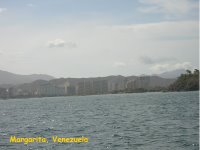 We did stock up on some provisions there and the prices were great. We had planned to stay a few more days but a tropical wave was heading our way. If we waited for it to pass we would have had to stay for another week. The wind looked good so we decided to leave on July 1. When we checked in at Margarita, we did an international check in and a national check in - we also checked out at the same time - otherwise we might have been delayed for another week. We heard many stories of people still waiting for there clearance papers. There is no guarantee of anything in Venezuela - part of the excitement :)
We did stock up on some provisions there and the prices were great. We had planned to stay a few more days but a tropical wave was heading our way. If we waited for it to pass we would have had to stay for another week. The wind looked good so we decided to leave on July 1. When we checked in at Margarita, we did an international check in and a national check in - we also checked out at the same time - otherwise we might have been delayed for another week. We heard many stories of people still waiting for there clearance papers. There is no guarantee of anything in Venezuela - part of the excitement :)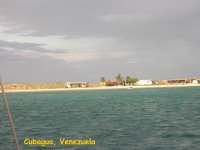 We left Porlamar, Margarita at 10:30 AM heading for Cubagua to overnight and shorten the trip to Puerto La Cruz. We arrived at 2:50 PM (14:50). When Christoper Columbus was in Peninsula de Paria (on the mainland of Venezuela) he saw some natives with pearls and spread the word. Within a year Christobal De LaGuerra and Pedro Alfonso Nino found that the source of the pearls to be the pearl beds off Cubagua. In 1492 fortune hunters arrived and founded Nueva Cadiz on the east side of the island. They took Indians as slaves and forced them to dive for pearls. They worked them so hard, whipping them when they would not dive, that hundreds of Indians died. At the height of the pearling industry Cubagua pearls provided Spain with a wealth almost equal to that of the gold transported from Inca lands. In one year alone Cubagua exported 820 pounds of pearls.
We left Porlamar, Margarita at 10:30 AM heading for Cubagua to overnight and shorten the trip to Puerto La Cruz. We arrived at 2:50 PM (14:50). When Christoper Columbus was in Peninsula de Paria (on the mainland of Venezuela) he saw some natives with pearls and spread the word. Within a year Christobal De LaGuerra and Pedro Alfonso Nino found that the source of the pearls to be the pearl beds off Cubagua. In 1492 fortune hunters arrived and founded Nueva Cadiz on the east side of the island. They took Indians as slaves and forced them to dive for pearls. They worked them so hard, whipping them when they would not dive, that hundreds of Indians died. At the height of the pearling industry Cubagua pearls provided Spain with a wealth almost equal to that of the gold transported from Inca lands. In one year alone Cubagua exported 820 pounds of pearls.In 1520, 300 Indians attacked the town and forced the Spaniards to leave. The Spaniards came back in force and rebuilt the town fortifying their houses againsts attack. A fort was also built over on the mainland to secure a water supply. After about 20 years the pearls decreased and new beds were sought in Coche and Cumana. On Christmas day in 1541 an earthquake and tidal wave destroyed Nueva Cadiz. Now Cubagua is uninhabited except for a small research station and a few fishing camps. We do not know what the research station is for, but we anchored in front of the fishing camps. We left early the next morning at 6:00 AM heading for Puerto La Cruz, so we did not get a chance to explore the ruins of the pearl farms.
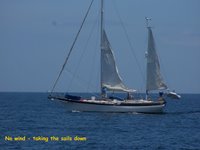 Sunday, July 2, we headed out for Puerto La Cruz, our final destination in Venezuela. The winds were again very light and we ended up motoring or motor sailing most of the way.
Sunday, July 2, we headed out for Puerto La Cruz, our final destination in Venezuela. The winds were again very light and we ended up motoring or motor sailing most of the way. 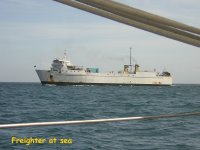 We saw dolphins on this leg of the trip, but could not get good photos. Two of them came right up to our bow and swam under our boat then left. We saw many large tankers our there, this one coming pretty close. You have to keep a good eye, they sneak up right behind you :0....
We saw dolphins on this leg of the trip, but could not get good photos. Two of them came right up to our bow and swam under our boat then left. We saw many large tankers our there, this one coming pretty close. You have to keep a good eye, they sneak up right behind you :0.... The offshore islands of Venezuela were very beautiful and
The offshore islands of Venezuela were very beautiful and
picturesque.

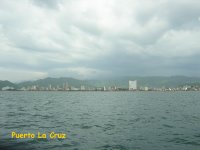 We arrived in Puerto La Cruz on Sunday about 4:30 PM (16:30) and put Ka'imi in a slip for the first time. Captain Mike did an exceptional job as usual!!!! We will take some pictures of the boat in the slip and show you in another posting.
We arrived in Puerto La Cruz on Sunday about 4:30 PM (16:30) and put Ka'imi in a slip for the first time. Captain Mike did an exceptional job as usual!!!! We will take some pictures of the boat in the slip and show you in another posting.Es un lugar barbaro! Hasta luego, Miguel and Kim
No comments :
Post a Comment